Three Women Sharing a Mantle in 6th Century BCE Greek Vase-Painting: Plurality, Unity, Family, and Social Bond
Abstract
1. Introduction
2. Results
2.1. Plurality and Unity
2.1.1. Overlap
2.1.2. Clothes, Groups of Deities
2.2. Family Ties and Affection
2.3. Choruses
3. Conclusions
4. Catalog
- Corinthian column crater. Paris, Louvre Museum E634. From Caere. Ca. 600–590 BCE. Attributed to the Memnon Painter and the “Three maiden Group.” Procession: Twice, two groups of three women assembled under the same mantle flanking a bearded man who holds a spear. Bibliography: (Buchholz 1987, No.40), with litt.
- Corinthian column crater. Basel, Antikensammlung BS444. Maybe from Argos. Ca. 580–570 BCE. The “Three maiden Group”, maybe Memnon Painter. Obverse: Two groups of three women grouped under the same mantle plus two women sharing the same mantle. The groups of women alternate with men holding a spear following a processional schema. Reverse: Horse riders. Bibliography: BAPD 1008775; CVA Basel 1, pl.12, n. 15. et pl. 13,6; (Buchholz 1987, No. 36 et No. 41 with litt).
- Corinthian Column Crater. Vatican, Museo Gregoriano Etrusco 126 (16448). From Caere. Ca. 600–580 BCE. Wedding procession: Three groups of three women assembled under the same mantle. Wedded couple riding on a chariot, men with spears. BAPD 9019291. Bibliography: (Buchholz 1987, No. 42).
- Corinthian column crater. Rome Villa Giulia Museum 46.197. From Cerveteri. Ca. 590–580 BCE. Three groups of three women assembled under the same mantle. Each group is facing a man riding on a chariot. Bibliography: (Amyx 1961, 11 n. 31; Gjo̵desen 1963, 338 n.28, Pl. 70 Figure 5).
- Fragment(s) of a Corinthian column crater. The Hague, Scheurleer Museum 2032–2033. (with a fragment in Copenhagen, National Museum 12.350). From Rhodes. Early sixth century BCE. Three women under the same mantle facing a wedded couple riding on a chariot. Bibliography: CVA La Hague, Musée Scheurleer 2 III C 14, Pl. 8.3; (Benson 1969, Figure 14; Buchholz 1987, No. 44).
- Fragment of a Corinthian column crater. The Hague, Scheurleer Museum. 2034. From Rhodes. Early sixth century BCE. Three women grouped under the same mantle. A man with a spear. Bibliography: CVA La Hague, Musée Scheurleer 2, III C 14, Pl.8.4.
- Black-figured pinax fragment (Corinthian). Athens National Museum. Maybe from Pitsa. Ca. 600–580 BCE. According to Orlandos: “the lower half of three figures covered by one and the same garment, as on the François Vase”. Bibliography: (Buchholz 1987, No. 43) (with litt.); (Orlandos 1935, p. 5; Jucker 1963, p. 56; Larson and Larson 2001, p. 261, Figure 5.18).
- Black-figured cup (Attic). Berlin, Staatlische Museen F3993 (lost). From Argos. Early 6th century BCE. Obverse: Nine women grouped under the same mantle. The first, at right, is holding a wreath. In front of them is a young man. At the left: Two men. Reverse: Seven women grouped under the same mantle. BAPD 44223. Bibliography: (Furtwängler 1883–1887, pl.51; Buchholz 1987, no. 50 with litt).
- Black-figured dinos (Attic). London, British Museum 1971, 1101.1. Signed by Sophilos. Ca. 580 BCE. Maybe from Cerveteri, Etruria (de La Genière 1995, p. 39). BAPD 350099; Para. 16 bis; Add2. 40.16 bis; (Buchholz 1987), No. 45.
- Black-figured volute crater (Attic). Florence Museo Archeologico Etrusco inv. 4209. From Chiusi. Signed by Kleitias (painter) and Ergotimos (Potter). Ca. 570 BCE. BAPD 300000. ABV. 76.1, 682, Para. 29; Add2. 21Bibliography: (Buchholz 1987, No. 46; Shapiro et al. 2013 with litt).
- Black-figured psykter (Chalcidian). Rome Coll. Castellani 47. From Caere. Ca. 540–530 BCE. Three women under the same mantle. Bibliography: (Buchholz 1987, No. 47 with litt).
- Black-figured lidded amphora (Eretrian). Athens, National Museum 1004. Middle 6th century BCE. On the belly: wedding procession. Three women grouped under the same mantle followed by an aulos player and a wedded couple (deities or heroes) riding on a chariot. Following the chariot: Dionysos and Aphrodite (?). In the front of the procession: a torch bearer (Artemis?). Two small sirens fly below and before the horses. On the neck: Judgment of Paris. Reverse: Siren. Funerary amphora used to contain the remains of a child. Bibliography: (Collignon et al. 1902, pp. 200–02, n. 667; Boardman 1952, pp. 32–35, Pl. 9 a-b, Pl. 11a, 1998, p. 216, Figure 458.1).
Funding
Acknowledgments
Conflicts of Interest
References
- Amyx, Darrell Arllyn. 1961. The Medallion Painter. American Journal of Archaeology 65: 1–15. [Google Scholar] [CrossRef]
- Cusset, Christophe, and Benjamin Acosta-Hugues. 2012. Euphorion, Oeuvres poétiques. Paris: Belles Lettres, n. 138. pp. 198–99. [Google Scholar]
- Bettini, Maurizio, and Luigi Spina. 2010. Le Mythe Des Sirènes. Paris: Belin. [Google Scholar]
- Benson, Jack L. 1969. The Three Maidens Group. American Journal of Archaeology 73: 109–22. [Google Scholar] [CrossRef]
- Boardman, John. 1952. Pottery from Eretria. The Annual of the British School at Athens 47: 1–48. [Google Scholar] [CrossRef]
- Boardman, John. 1998. Early Greek Vase Painting: 11th–6th Centuries BC: A Handbook. London: Thames and Hudson. [Google Scholar]
- Boardman, John. 2003. Athenian Black-Figure Vases. London: Thames & Hudson. [Google Scholar]
- Bodiou, Lydie, Dominique Frère, Véronique Mehl, and Alexandre Tourraix, eds. 2006. L’expression des Corps: Gestes, Attitudes, Regards dans l’iconographie Antique. Histoire, Cahiers d’histoire du corps antique; no. 2. Rennes: Presses Universitaires de Rennes. [Google Scholar]
- Bonfante, Larissa. 1989. Nudity as a Costume in Classical Art. American Journal of Archaeology 93: 543–70. [Google Scholar] [CrossRef]
- Buchholz, Hans-Günter. 1987. Das Symbol des gemeinsamen Mantels. Jahrbuch des Deutschen Archäologischen Instituts 102: 1–55. [Google Scholar]
- Budelmann, Felix. 2014. Greek Festivals in and out of Context. In Choruses, Ancient and Modern. Edited by Joshua H. Billings, Felix Budelmann and Fiona Macintosh. Oxford: Oxford University Press, pp. 81–99. [Google Scholar]
- Budelmann, Felix, and Timothy Power. 2015. Another Look at Female Choruses in Classical Athens. Classical Antiquity 34: 252–95. [Google Scholar] [CrossRef]
- Burkert, Walter. 2011. La religion grecque: À l’époque archaïque et classique. Antiquité/Synthèses, 13. Paris: Picard. [Google Scholar]
- Cairns, Douglas L. 1996a. Off with Her ΑΙΔΩΣ’: Herodotus 1.8.3-4. Classical Quarterly 46: 78–83. [Google Scholar] [CrossRef]
- Cairns, Douglas L. 1996b. Veiling, Αίδώς, and a Red-Figure Amphora by Phintias. The Journal of Hellenic Studies 116: 152–58. [Google Scholar] [CrossRef][Green Version]
- Cairns, DouglasL. 2002. The Meaning of the Veil in Ancient Greek Culture. In Women’s Dress in the Ancient Greek World. Edited by Lloyd Llewellyn-Jones. London: Duckworth, Swansea: Classical Press of Wales, pp. 73–93. [Google Scholar]
- Calame, Claude. 1977. Les chœurs de Jeunes Filles en Grèce Archaïque. Filologia e critica; 20–21. Roma: Edizioni dell’Ateneo & Bizzarri. [Google Scholar]
- Cohen, Beth. 2001. Ethnic Identity in Democratic Athens and the Visual Vocabulary of Male Costume. In Ancient Perceptions of Greek Ethnicity. Edited by I. Malkin. Washington: Center of Hellenic Studies, Harvard University Press, pp. 235–74. [Google Scholar]
- Collignon, Maxime, Louis Couve, and Georges Nicole. 1902. Catalogue des Vases Peints du Musée National d’Athènes. Paris: A. Fontenmoing. Available online: http://archive.org/details/cataloguedesvas00gregoog (accessed on 1 April 2019).
- Crowhurst, Richard. 1963. Representations of Performance of Choral Lyric on the Greek Monuments, 800-350 B.C. Ph.D. Thesis, University of London, London, UK. [Google Scholar]
- Danielewicz, Jerzy. 1990. Towards an Understanding of the Chorus: Homer on Early Forms of Lyric Poetry. Eos: Commentarii Societatis Philologae Polonorum 78: 55–62. [Google Scholar]
- Dasen, Veronique. 1997. Multiple Births in Graeco-Roman Antiquity. Oxford Journal of Archaeology 16: 49–63. [Google Scholar] [CrossRef]
- Deonna, W. 1914. Unité et Diversité. Revue Archéologique 23: 39–58. [Google Scholar]
- Fridh-Haneson, Britt Marie. 1983. Le manteau symbolique: Étude sur les couples votifs en terre cuite assis sous un même manteau. Skrifter utgivna av Svenska institutet i Rom. 4°; 40. Stockholm: Svenska Institutet i Rom, Distributor PÅströms. [Google Scholar]
- Furtwängler, Adolph. 1883. Die Sammlung Sabouroff. Berlin: Asher. Available online: http://digi.ub.uni-heidelberg.de/diglit/furtwaengler18831887bd1 (accessed on 29 March 2019).
- Gantz, Timothy. 1993. Early Greek Myth: A Guide to Literary and Artistic Sources. Baltimore: Johns Hopkins University Press. [Google Scholar]
- Genière, Juliette de la. 1987. Des usages du cratère. Revue des Études Anciennes 89: 271–82. [Google Scholar] [CrossRef]
- Genière, Juliette de la. 1988. Les acheteurs des cratères corinthiens. Bulletin de Correspondance Hellénique 112: 83–90. [Google Scholar] [CrossRef]
- Genière, Juliette de la. 1995. Quand Le Peintre Sophilos Signait Ses Oeuvres. Monuments et Mémoires de La Fondation Eugène Piot 74: 35–43. [Google Scholar] [CrossRef]
- Gherchanoc, Florence, and Valérie Huet. 2007. Pratiques politiques et culturelles du vêtement. Revue historique 641: 3–30. [Google Scholar] [CrossRef]
- Gherchanoc, Florence, and Valérie Huet. 2008. S’habiller, Se Déhabiller Dans Les Mondes Anciens. Mètis. Anthropologie Des Mondes Grecs Anciens 6. Paris-Athènes: Ehess-Deadalus. [Google Scholar]
- Gjo̵desen, Mogens. 1963. Greek Bronzes: A Review Article. American Journal of Archaeology 67: 333–51. [Google Scholar] [CrossRef]
- Guarducci, Margherita. 1928. Due o più donne sotto un solo manto in una serie di vasi greci arcaici. Mitteilungen des Deutschen Archäologischen Instituts, Athenische Abteilung LIII: 52–65. [Google Scholar]
- Halm-Tisserant, Monique. 2005. Nommer Les Dieux Au Flanc Des Vases. In Nommer Les Dieux: Théonymes, Épithètes, Épiclèses Dans l’Antiquité. Edited by Nicole Brepols Belayche. Presses universitaires de Rennes, 41–51. Recherches Sur Les Rhétoriques Religieuses 5. Turnhout: Rennes. [Google Scholar]
- Hésiode. 2008. Théogonie. Translated by Paul Mazon. Classiques En Poche 88. Paris: Les Belles Lettres. [Google Scholar]
- Iozzo, Mario. 2013. The François Vase: Notes on Technical Aspects and Function. In The François Vase: New Perspectives. Edited by Harvey Alan Shapiro, Mario Iozzo and A. Lezzi-Hafter. Zürich: Akanthus, pp. 53–65. [Google Scholar]
- Isler-Kerényi, Cornelia. 1997. Der François-Krater Zwischen Athen Und Chuisi. In Athenian Potters and Painters: The Conference Proceedings. Edited by John Howard Oakley, William D. E. Coulson and Olga Palagia. Oxford: Oxbow Monograph 67. [Google Scholar]
- Jenkins, I. D. 1985. The Ambiguity of Greek Textiles. Arethusa 18: 109–32. Available online: https://search.proquest.com/docview/1307036898/citation/DA5E1E2611848F2PQ/1 (accessed on 2 May 2019).
- Johnston, Sarah Iles. 1999. Restless Dead: Encounters Between the Living and the Dead in Ancient Greece. Berkeley: University of California Press. [Google Scholar]
- Jucker, Ines. 1963. Frauenfest in Korinth. Antike Kunst 6: 47–61. [Google Scholar]
- Jones, William Henry Samuel, and Henry Ardene Ormerod. 1918. Description of Greece. Translated by Pausanias. 4 vols. Cambridge: Harvard University Press. [Google Scholar]
- Karoglou, Kyriaki. 2010. Attic Pinakes: Votive Images in Clay. BAR. International Series 2104; Oxford: Archaeopress. [Google Scholar]
- Koch-Harnack, Gundel. 1989. Erotische Symbole: Lotosblüte und gemeinsamer Mantel auf Antiken Vasen. Berlin: Mann. [Google Scholar]
- Kurtz, Donna C., and John Boardman. 1971. Greek Burial Customs. Aspects of Greek and Roman Life. London: Thames and Hudson. [Google Scholar]
- Ladianou, Katerina. 2016. Female Choruses and Garden of Nymphs: Visualizing Chorality in Sappho. In The Look of Lyric: Greek Song and the Visual. Studies in Archaic and Classical Greek Song. Edited by Vanessa Cazzato and André Lardinois. Leiden: Brill, vol. 1, pp. 343–69. [Google Scholar]
- Larson, Jennifer, and Jennifer Lynn Larson. 2001. Greek Nymphs: Myth, Cult, Lore. Oxford: Oxford University Press. [Google Scholar]
- Lee, Mireille M. 2012. Dress and Adornment in Archaic and Classical Greece. In A Companion to Women in the Ancient World. Edited by Sharon L. James and Sheila Dillon. Chichester and Malden: Wiley-Blackwell, pp. 179–90. [Google Scholar]
- Lissarrague, François. 1990. L’autre Guerrier: Archers, Peltastes, Cavaliers dans l’imagerie Attique. Images à l’appui; 3. Paris: Découverte. Rome: École française de Rome. [Google Scholar]
- Lissarrague, François. 1999. Vases Grecs: Les Athéniens et Leurs Images. Paris: F. Hazan. [Google Scholar]
- Lissarrague, François. 2015. Ways of Looking at Greek Vases. In A Companion to Ancient Aesthetics. Edited by Pierre Destrée and Penelope Murray. Hoboken: John Wiley & Sons, Inc., pp. 237–47. Available online: http://onlinelibrary.wiley.com/doi/10.1002/9781119009795.ch15/summary (accessed on 23 March 2016).
- Llewellyn-Jones, Lloyd. 2003. Aphrodite’s Tortoise: The Veiled Woman of Ancient Greece. Swansea: Classical Press of Wales. Oakville: Distributor in the United States, David Brown. [Google Scholar]
- Murray, Penelope. 2008. Qu’est-Ce Qu’une Muse? Mètis. Anthropologie Des Mondes Grecs Anciens 6: 199–219. [Google Scholar]
- Nagy, Gregory. 1999. The Best of the Achaeans: Concepts of the Hero in Archaic Greek Poetry. Baltimore: Johns Hopkins University Press. [Google Scholar]
- Oakley, John Howard, and Rebecca H. Sinos. 1993. The Wedding in Ancient Athens. Madison: University of Wisconsin Press. [Google Scholar]
- Orlandos, Anastasios. 1935. The Discovery of Painted Pinakes near Corinth. American Journal of Archaeology 39: 5. [Google Scholar] [CrossRef]
- Paléothodoros, Dimitris. 2002. “Pourquoi Les Étrusques Achetaient-Ils Des Vases Attiques?”. Les Études Classiques 70: 139–60. [Google Scholar]
- Pipili, Maria. 2000. Wearing an Other Hat: Workmen in Town and Country. In Not the Classical Ideal: Athens and the Construction of the Other in Greek Art. Edited by Beth Cohen. Leiden: Brill, p. XVI. 559p. [Google Scholar]
- Pirenne-Delforge, Vinciane, and Gabriella Pironti. 2011. Les Moires entre la naissance et la mort: De la représentation au culte. Études de lettres 3–4: 93–114. [Google Scholar] [CrossRef]
- Pironti, Gabriella. 2009. Dans l’entourage de Thémis: Les Moires et Les ‘Normes Parthénoniques’. In La Norme En Matière Religieuse En Grèce Ancienne: Actes Du XIe Colloque Du CIERGA (Rennes, Septembre 2007). Kernos Suppléments 21. Liège: Centre International d’étude de la Religion Grecque Antique, pp. 13–27. [Google Scholar]
- Pironti, Gabriella. 2013. Entre ciel et guerre: Figures d’Aphrodite en Grèce ancienne. Kernos Suppléments. Liége: Presses Universitaires de Liège. Available online: http://books.openedition.org/pulg/236 (accessed on 11 July 2019).
- Rabinowitz, Nancy Sorkin. 2002. Excavating Women’s Homoeroticism in Ancient Greece: The Evidence from Attic Vase Painting. In Among Women: From the Homosocial to the Homoerotic in the Ancient World. Austin: University of Texas Press, pp. 106–66. [Google Scholar]
- Reusser, Christoph. 2013. The François Vase in the Context of the Earliest Attic Imports to Etruria. In The François Vase: New Perspectives. Edited by Harvey Alan Shapiro, Mario Iozzo and Adrienne Lezzi-Hafter. Zürich: Akanthus, pp. 33–52. [Google Scholar]
- Rodríguez-Pérez, Diana, ed. 2017. Greek Art in Context. Archaeological and Art Historical Perspectives. London and New York: Routledge. [Google Scholar]
- Rudhardt, Jean. 1999. Thémis et les Hôrai: Recherche sur les divinités grecques de la justice et de la paix. Recherches et rencontres; 14. Genève: Droz. [Google Scholar]
- Scheid, John, and Jesper Svenbro. 1994. Le Métier de Zeus, Mythe Du Tissage et Du Tissu Dans Le Monde Gréco-Romain. Paris: La découverte. [Google Scholar]
- Shapiro, Harvey Alan., Mario Iozzo, and Adrienne Lezzi-Hafter. 2013. The François Vase: New Perspectives. Paper presented at the International Symposium, Villa Spelman, Florence, May 23–24; Kilchberg and Zürich: Akanthus Verl. für Archäologie. [Google Scholar]
- Squire, Michael. 2015. Conceptualizing the (Visual) ‘Arts’. In A Companion to Ancient Aesthetics. Edited by Pierre Destrée and Penelope Murray. Hoboken: John Wiley & Sons, Inc., pp. 307–26. Available online: http://onlinelibrary.wiley.com/doi/10.1002/9781119009795.ch20/summary (accessed on 23 March 2016).
- Steiner, Ann. 2007. Reading Greek Vases. New York: Cambridge University Press. [Google Scholar]
- Stewart, Andrew F. 1997. Art, Desire, and the Body in Ancient Greece. Cambridge: Cambridge University Press. [Google Scholar]
- Sutton, Robert F., Jr. 1981. The Interaction between Men and Women Potrayed on Attic Red-Figure Pottery. Ph.D. Dissertation, University of North Carolina, Chapel Hill, NC, USA. [Google Scholar]
- Swift, Louise. 2016. Visual Imagery in Parthenaic Song. In The Look of Lyric: Greek Song and the Visual. Edited by Vanessa Cazzato and André Lardinois. Leiden: Brill, pp. 255–87. [Google Scholar]
- Torelli, Mario. 2013. The Destiny of the Hero- toward a Structural Reading of the François Krater. In The François Vase: New Perspectives, Paper presented at the International Symposium Villa Spelman, Florence, Italy, May 23–24. Edited by Harvey Alan Shapiro, Mario Iozzo and Adrienne Lezzi-Hafter. Zurich: Akanthus, pp. 84–101. [Google Scholar]
- Vermeule, Emily. 1979. Aspects of Death in Early Greek Art and Poetry. Berkeley: University of California Press. [Google Scholar]
- Villanueva Puig, Marie-Christine. 2004. Deux Ménades Sous Le Même Manteau? Revue Des Études Anciennes 106: 445–54. [Google Scholar]
- West, Martin L. 1966. Theogony. Translated by Hesiod. Oxford: Clarendon. [Google Scholar]
- Williams, Dryfi. 1983. Sophilos in the British Museum. In Greek Vases in the J. Paul Getty Museum. Occasional Papers on Antiquity 1. Malibu: The J. Paul Getty Museum, pp. 9–34. [Google Scholar]
| 1 | The bibliography on this subject is extensive. Since reconsidering theoretical approaches on ancient Greek iconography is not the subject of this paper, see for recent analysis: (Steiner 2007; Lissarrague 2015; Squire 2015). On context in ancient Greek art: (Rodríguez-Pérez 2017). |
| 2 | LSJ s.v. ἱμάτιον. |
| 3 | Paris, Louvre Museum G 42 (BAPD 200116ARV2. 23.1, 1620; Add2. 154). On the veil: (Cairns 2002; Llewellyn-Jones 2003, pp. 41–83, 85–120). On Leto’s modesty: (Cairns 1996a, 1996b). |
| 4 | Hom. Od. 11.576–581. |
| 5 | Attic black-figure lekythos, attributed to the Amasis Painter (ca. 550–530 BCE), New York, Metropolitan Museum of Art 56.11.1 (BAPD 350478 Para.66). Also: Attic black-figure amphora (ca. 520 BCE), London, British Museum B171 (BAPD 5725). Obverse: Judgment of Paris: Hera and Aphrodite are wearing embroidered himatia wrapped around their shoulders. |
| 6 | For example: Attic red-figure cup (ca. 480 BCE), Durham, Private (BAPD 352458; Para. 336), on which a man and a woman are lying on a klinè and covered by a mantle. The same idea is on an Attic red-figured cup attributed to the Eucharides Painter (ca. 490 BCE), New-York, Metropolitan Museum of Art 19.192.32 (BAPD 202282; ARV2.231.80; Add2.200). See (Buchholz 1987, pp. 20–47). However, there are some depictions of two men sharing a cloak in sixth-century black-figure vase painting. For example, two young men sharing a cloak: Attic black-figure lekythos (ca. 525–500 BCE), Paris, Louvre Museum F194 (BAPD 10130; Haspels, ABL 65, note 1). |
| 7 | Attic black figure pyxis, (ca. 550–540 BCE), Athens, national Museum 500 (BAPD 301468; ABV. 302.2): Three women sharing the same piece of cloth. Attic black-figure lekythos, attributed to the Pharos Painter (ca. 550 BCE), New York, Metropolitan Museum of Art 75.2.10 (BAPD 370003; ABV. 698; Para. 199.1; Haspels, ABL. 194.1, 5, 25, PL.8.1): two women facing each other in one cloak. |
| 8 | State of the question: (Villanueva Puig 2004). Studies before 1987: (Buchholz 1987, pp. 17–19). |
| 9 | Attic red figure cup (fragment), ca. 525–500 BCE, Paris, Louvre Museum G 99 (BAPD 201652; ARV2. 180.1; Add2. 186.). |
| 10 | On this point see (Burkert 2011, pp. 144–46 pompè) with bibliography. |
| 11 | On the anakalypsis and anakaluptêria see: schol. Eur. Phoenic. 682, attributed to Euphorion of Chalcis (Cusset and Acosta-Hugues 2012; Llewellyn-Jones 2003, pp. 98–104). |
| 12 | The goddess is holding a flower, an attribute related to Aphrodite and her seductive powers over humans and animals (for example: Homeric Hymn to Aphrodite, 1–6; 68–74; Hom. Il.14.214–219, etc.). For example, a “Nikosthenic” amphora in the Six technique dated ca. 520–510 BCE, in Paris, Louvre Museum F 114, shows a naked girl holding a flower near her face. The picture is like a nude study, carefully drawn, emphasizing the beauty and erotic appeal of the girl (BAPD 302837; ABV.226; Add2. 58). See also: Attic black-figure amphora fragment (ca. 520 BCE), Boston, Museum of Fine Arts 03.849 (BAPD 591): A woman (maybe Aphrodite) holding a flower. Attic white-ground lekythos attributed to Douris (ca. 500–490 BCE), Cleveland Museum of Art 1966.114 (BAPD 275976; Para.376.266 Bis; Add2. 241): Atalanta running between erotes with wreath and flowering branches. Attic red-figure cup (ca. 490 BCE), New York Metropolitan Museum of Arts 07.286.5 (BAPD 209975; ARV2.806.): Aphrodite (named) holding a flower. On Aphrodite: (Pironti 2013, pp. 153–208). |
| 13 | Hom. Il. 18. 491–493: “and by the light of the blazing torches (δαΐδων ὕπο λαμπομενάων) they were leading the brides from their rooms through the city, and loud rose the bridal song” (trans. A. T. Murray). See also: Eur. Hel. 722–724; Ion 1475; Med. 1026–1027; Phoen. 344–345; Tro. 308–324; Diod. 13.84.2–3; Tac. Ann. 15.37; (Oakley and Sinos 1993, pp. 26–28). |
| 14 | New York, Metropolitan Museum of Art 56.11.1 (see note 5). Also: Attic black-figure hydria (ca. 550–530 BCE), Paris, Louvre Museum F 42 (BAPD 301479; ABV.304.1; Add2.79): A wedded couple in a chariot, facing them, a woman holding torches. Attic black-figure hydria (ca. 530 BCE), Fiesole, A. Costantini (BAPD 6811): Wedded couple in a chariot, facing them a woman with torches. Very similar: Attic black figure neck-amphora (ca. 520–500 BCE), Paris, Louvre Museum F 232 (BAPD 320230; ABV. 281.10). |
| 15 | See also the Dioscuri on an Attic black-figured hydria (ca. 560–540 BCE). Basel, Antikenmuseum BS 1401 (BAPD 4422; LIMC III s.v. Dioskouroi 180). As pointed by V. Dasen, the twins are pictured “superimposed with a slight overlap” with “Dioskoro” in the dual written next to them, emphasizing that they are an indivisible entity (Dasen 1997, p. 53). |
| 16 | On pinakes: (Karoglou 2010). |
| 17 | |
| 18 | Eur. Hel. 167–178; See also: Attic, black-figure funerary plaque (ca. 625–610 BCE), Boston, Museum of Fine Arts 27.146 (BAPD 3748): Prothesis with a siren under the funerary bed (in connection with Boston, Museum of Fine Arts 27.147: Three women mourning (BAPD 4959); LIMC spp. 1. s.v. seirenes. |
| 19 | Geryon: Hes. Theog. 287–294. See also: Attic black-figure amphora, (ca. 550–530 BCE), London British Museum B157 (BAPD 11916; CVA, London, British Museum 3, III He. 4, Pl. 26. 3A-D; LIMC IVs.v. Eurythion II 15); Attic black-figure amphora (ca. 540 BCE). New York, Metropolitan Museum of Art 56.171.11 (BAPD 301036; ABV. 133.2; Para. 54; CVA, New York, Metropolitan Museum of Art 3, Pl. 15. 1-2.; LIMC IV, s.v. Eurythion II 12; V., s.v. Herakles 2484). |
| 20 | Corinthian column crater (ca. 590–570 BCE), Basel, Antikensammlungen BS 451 (CVA, Basel, Antikenmuseum 1, 47–48, Pls. 14. 1–25, 15. 1-3). |
| 21 | Chalcidian amphora (ca. 540–530 BCE), Paris, Cabinet des Médaillles 202 (BAPD 909851; CVA, Paris, Bibliothèque Nationale 1, 19–21, pls. 24. 1-4, 25. 1-7); see also: “Pontic” amphora (ca. 550 BCE), Munich Antikensammlung SH837 (BAPD 9034556; CVA. Munich, Antikensammlungen ehemals Museum Antiker Keinkunst 17, 23, 24, 25, 26, Beilage 1.1, Pls. 5. 1-2, 6. 1-3.). Apollo’s cattle: Caeretan black-figure hydria (ca. 550–520 BCE), Paris, Louvre Museum E702 (BAPD 1007817; CVA Paris, Musée du Louvre 9, III. F.A.9, III. FA.10, Pls. 8.3-4, 10.1-7). |
| 22 | Laconian cup attributed to the Boreads Painter (ca. 550 BCE), Rome, Museo Nazionale Etrusco di Villa Giulia (LIMC III s.v. Boreadai 6 = LIMC IV s.v. Harpyiai 23). See also: Attic plate, black figure, attributed to Lydos (ca. 560 BCE), Oxford (Miss.), Robinson collection (BAPD 310200; ABV. 112.54; Para. 44; Add2. 31; CVA. Baltimore, Robinson Collection 1, 40, Pl. 19.1. A-B; LIMC III s.v. Boreadai 1); Attic black-figure cup (ca. 560 BCE), Athens, Acropolis Museum 1.1757 (BAPD 32393; LIMC III s.v. Boreadai 2); Attic black-figure column crater, attributed to the Cavalcade Painter (ca. 575 BCE) Thessaloniki, S. Andreadis Coll. (LIMC III s.v. Boreadai 4 = LIMC IV s.v. Harpyiai 21); Laconian cup attributed to the Boreads Painter from the Heraion of Samos (ca. 575–570 BCE). Samos, Vathy Museum K1540 and K 1206 (LIMC IV s.v. Harpyiai 22 = LIMC III s.v. Boreadai 5); Laconian cup attributed to the Boreads Painter (ca. 550–540 BCE), Malibu, J. P. Getty Museum 85.AE.461 (BAPD 1002343; LIMC IV s.v. Harpyiai 24). |
| 23 | Attic black-figure hydria attributed to the Priam Painter (ca. 540–530 BCE), Berlin, Antikensammlung F1905 (BAPD 301801; ABV. 332.23; Para. 146; Add2.90). |
| 24 | Hes. Theog. 95; Homeric Hymn to Apollo 131, 182–203. For example, Attic black-figure Amphora (A) attributed to the Priam Painter (ca. 540–530 BCE), Chiusi, Museo Archeologico Nazionale 1794 (BAPD 301779; ABV. 330.1; Para. 146; ARV2. 89): Artemis mounting in her chariot, accompanied by Apollo (named) playing cithara. Attic black-figure amphora (ca. 500–480 BCE), New York, Market, Christie’s (BAPD 29): young man playing cithara (Apollo?) between Hermes (caduceus, petasos) and Dionysos (cantharos, vine). See also LIMC II s.v. Apollo 82–238 (esp. Apollo 119, 120, 122), 689–733 (esp. 702, 779b and 780). |
| 25 | Also: Homeric Hymn to Apollo 182–203; Homeric hymn to Apollo and the Muses 1–3. |
| 26 | Attic black-figure amphora attributed to the Leagros Group (ca. 510–500 BCE), London, British Museum B 261 (BAPD 302171; ABV. 373.176; Para. 163; Add2. 99; CVA London, British Museum 4, III. He. 9, Pl. 64.2 A-B; LIMC VI, Pl. 387, s.v. Mousa-Mousai 28b). Also: Attic black-figure amphora attributed to the Leagros group (ca. 510–500 BCE), Agrigento, Museo Archeologico Regionale R 138 (BAPD 15752; CVA Agrigento, Museo Archeologico Nazionale 1, 13, Pls. 22.1–2, 23.1–2, 28.3). See Anne Queyrel commentaries in: LIMC VI s.v. Mousa-Mousai 28a,b, 32, 33, 124, 126, 129a, 137. |
| 27 | Attic black-figure amphora attributed to the Euphiletos Painter (ca. 520 BCE), Orvieto Museo Civico 273 (BAPD 301730; ABV. 325). See: (Villanueva Puig 2004). |
| 28 | LIMC III s.v. Dioskouroi 165, 180, 182; Tinas Cliniar 3, 4, 7, 9. See A. Hermary’ s commentaries: 567–593. |
| 29 | LIMC III sv. Charis, charites; LIMC V s.v. Horai (esp. commentary of V. Machaira: 508–510). |
| 30 | Paus. 5.17, 1. See also a limestone carved group (ca. 450 BCE). Paris, Louvre Museum Ca 442. Three deities (maybe Charites) standing next to each other, in a row. |
| 31 | Paus. 3.19, 4–5. |
| 32 | Paus. 5. 18, 4 (translation: Jonesand and Ormerod, (Jones and Ormerod 1918)). |
| 33 | Paus. 9.25, 4. |
| 34 | Paus. 9.35, 1-2. See: (Burkert 2011, p. 242, n. 576). |
| 35 | Paus. 2.20, 5; 5.15,3. |
| 36 | Hes. Theog. 1–75. On the cult of the Heliconian Muses: (Burkert 2011, p. 242, n. 575). See also, West commentary on Hesiod Theogony (1966), pp. 180–81. |
| 37 | Hes. Theog. 25, 29, 60, 76. |
| 38 | Hes. Theog. 901–911. See (Hesiod 1966, pp. 405–08). |
| 39 | LSJ s.v. θρόνος |
| 40 | Kleitarchos schol. Theoc. 2.59 (Scheid and Svenbro 1994, p. 63). |
| 41 | Hom. Od. 14. 486–502 (Eos); Hom. Il. 14. 154 (Hera); Aristoph. Birds, 904–905. |
| 42 | Pind. Pyth. 9.60; Nem. 3.83; Ol. 13.96. |
| 43 | Pind. Ol. 14.9–11. Note, also the special relationship to weaving since the Charites made Aphrodite’s peplos (Hom. Il. 5.338). |
| 44 | See: Homeric Hymn to Aphrodite, 60–65, 84–90 (Aphrodite), 218 (Eos); Hom. Il. 14, 170–186 (Hera) who wear beautiful and shiny clothes (ἀπολάμπω), a veil “white as the sun” (δ᾽ ἦν ἠέλιος ὥς). |
| 45 | Hes. Theog. 921–923. |
| 46 | Fragment of a dinos attributed to Sophilos (ca. 580 BCE). Athens, National Museum Acropolis collection 1.587 (BAPD 305074, ABV 39.15). |
| 47 | Pind. Pyth. 4, 103–105. |
| 48 | A solution to this odd association is, however, proposed by Torelli. For him, Chariklo is the nympheutria (“escort and prompter of the bride”), while Hestia and Demeter allude to the future of the bride. Hestia is depicted as the guardian of the hearth, Demeter as the protector of fecundity and other wealth and virtues of domestic life (Torelli 2013, pp. 92–93). The author does not mention that the three deities are assembled under the same himation, forming a group. |
| 49 | Hes. Theog. 60. |
| 50 | Pind. Ol. 7.6 (“marriage-bed”: ὁμόφρονος εὐνᾶς); Aristoph. Birds, 632 (“just, loyal and sacred bond”: ὁμόφρονας λόγους δικαίους). |
| 51 | Ps-Hes. Shield, 49–50. See Chantraine DELG s.v. φρήν. On Heracles and Iphicles, twin brothers but physically very different: Attic red-figured stamnos attributed to the Berlin Painter (ca. 480–470 BCE), Paris, Louvre Museum G 192 (BAPD 201979; ARV2. 208.160, 1633; Para. 343; Add2. 195; LIMC I s.v. Alkeme 8; Dasen 1997, pp. 51–52). |
| 52 | Hom. Il. 22.263. |
| 53 | LSJ s.v. ἑταῖρος. |
| 54 | Hes. Theog. 39. See (West 1966, p. 170). |
| 55 | Hes. Theog. 25, 29, 60, 76; Plu. De def.orac. 11. 415 c,d; Bacch. 17. 102–103. |
| 56 | Sappho fr. 44 Voigt; Hom. Il. 18. 491–495. |
| 57 | Paus. 5.18.4. See n. 18. |
| 58 | Pind. Pyth. 3.89–92; Eur. Iph. Aul. 1036–1047. |
| 59 | LIMC VI s.v. Mousa/Mousai 28a, b, 32, 33, 124, 126, 129a, 137 and commentary p. 673. Supra n. 21. |
| 60 | On the François vase as a wedding gift: Iozzo (2013) (Athenian context); Isler-Kerényi (1997) (Etruscan context). Corinthian craters: (Genière 1987, 1988). |
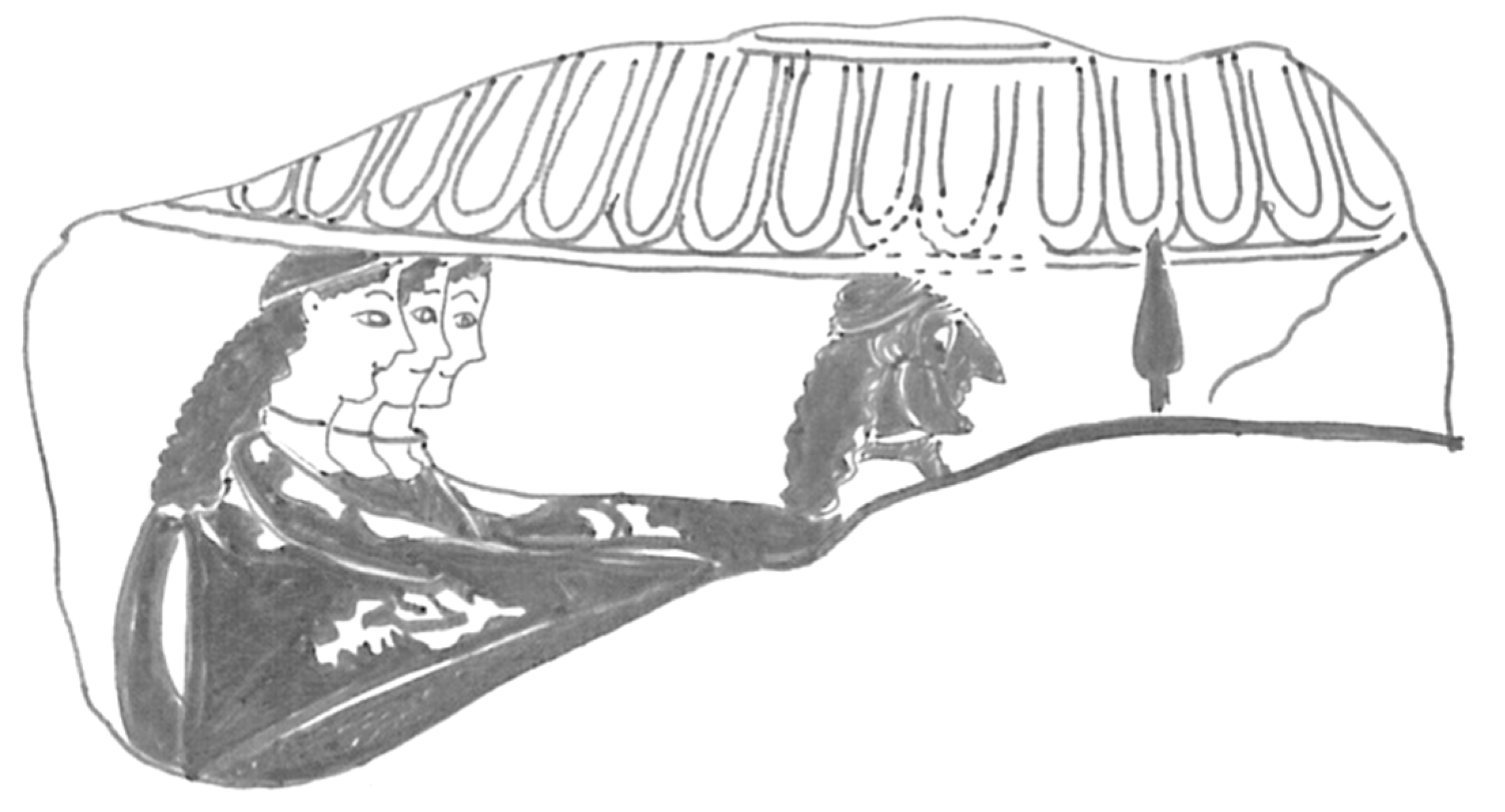
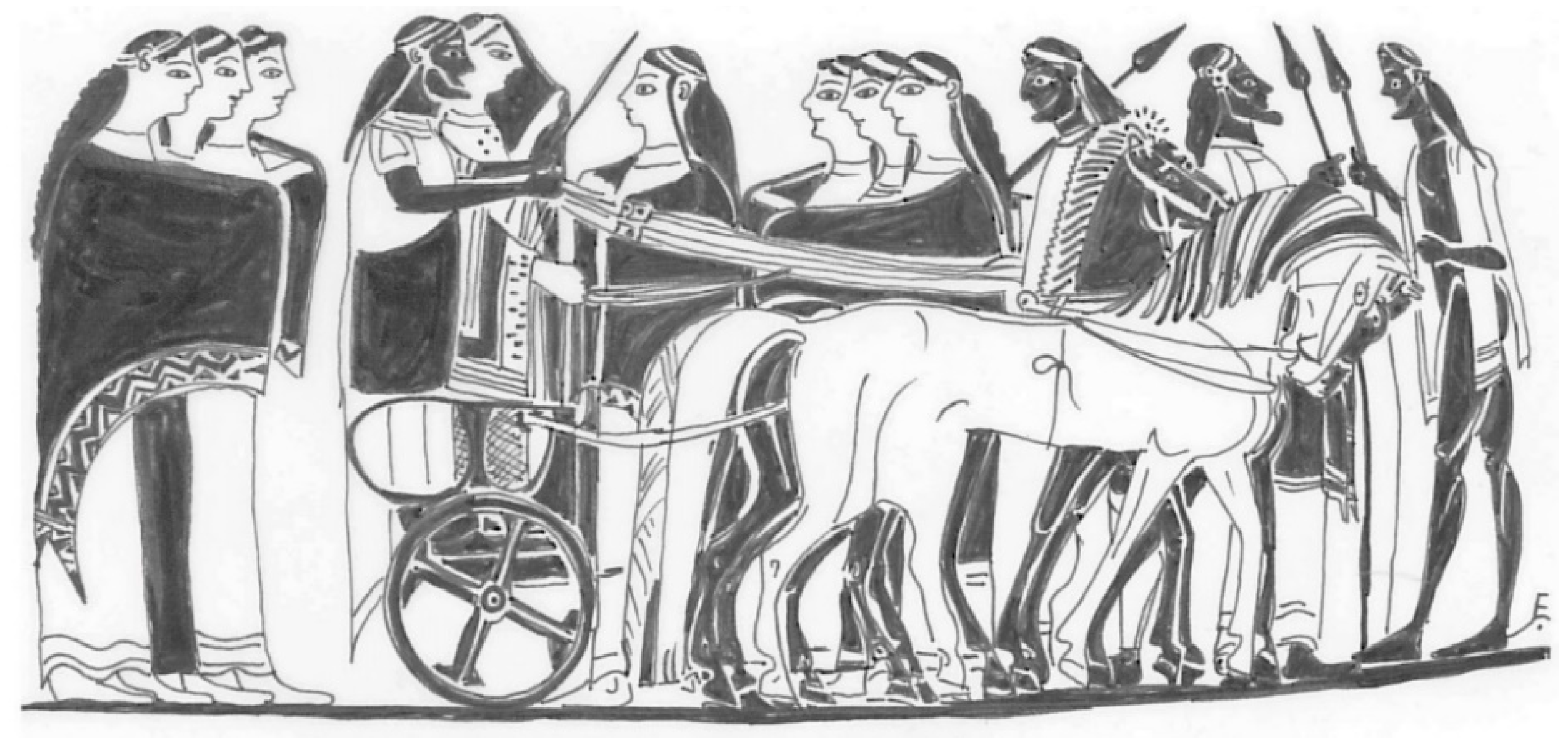
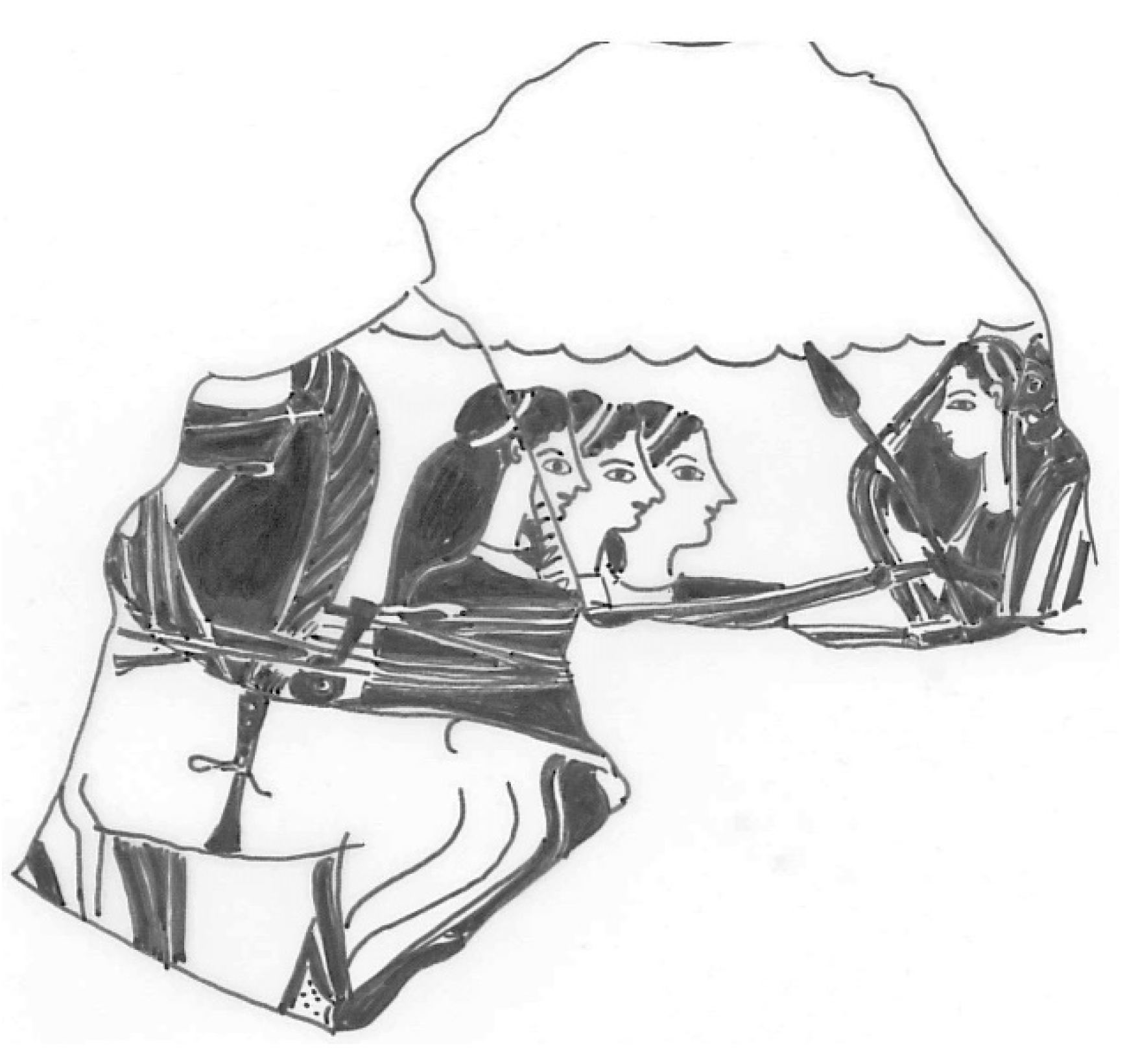
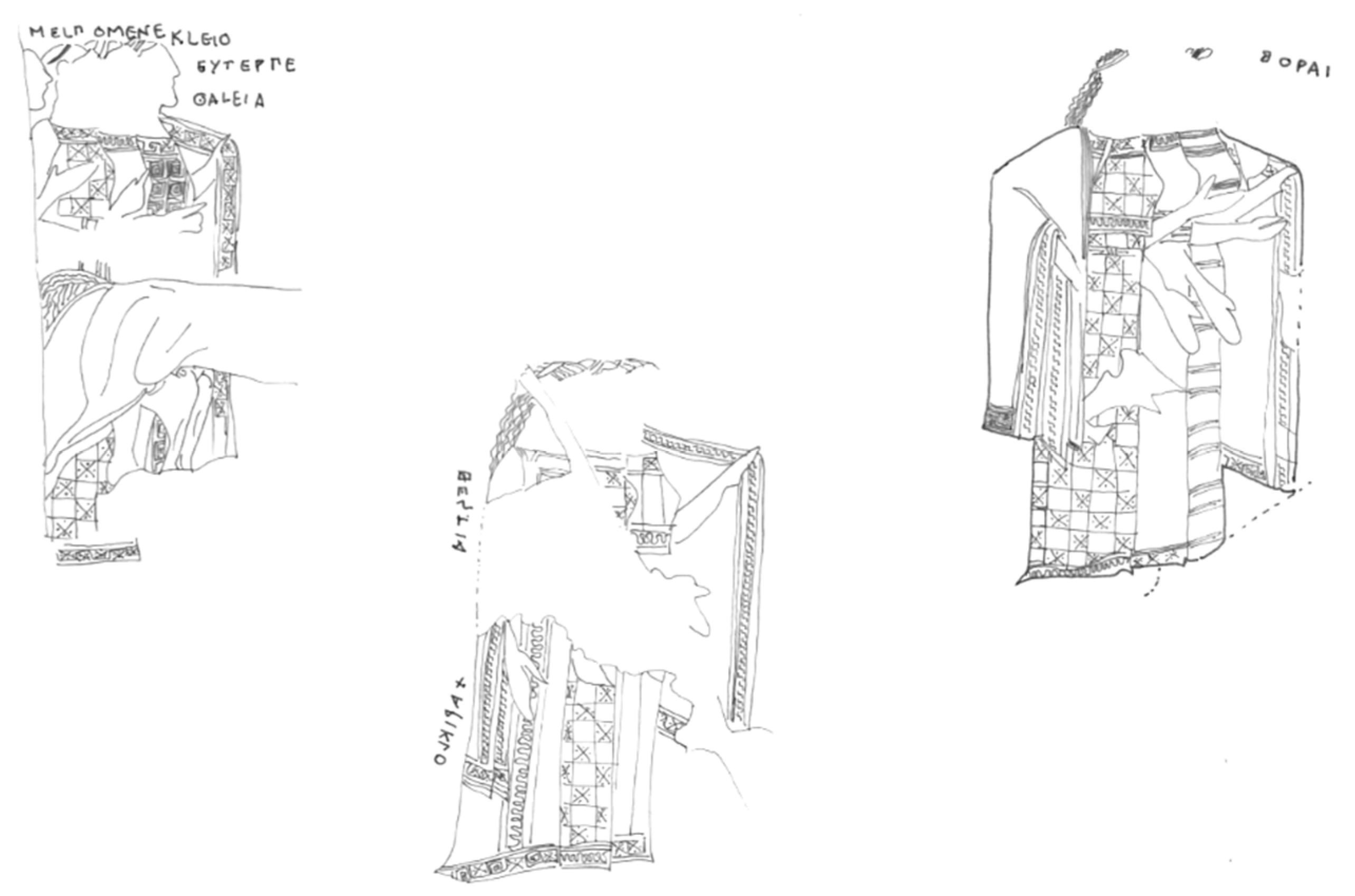

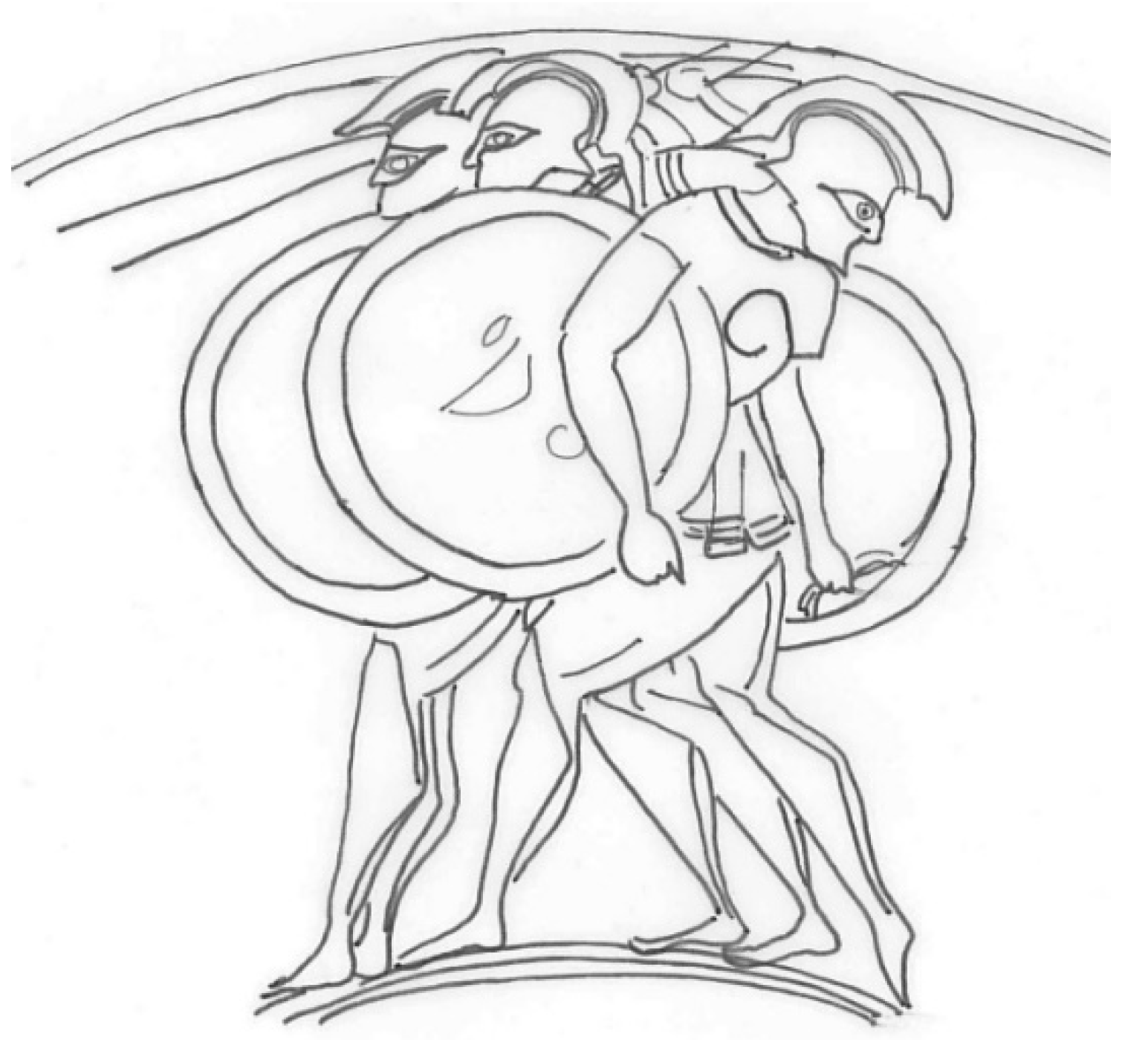

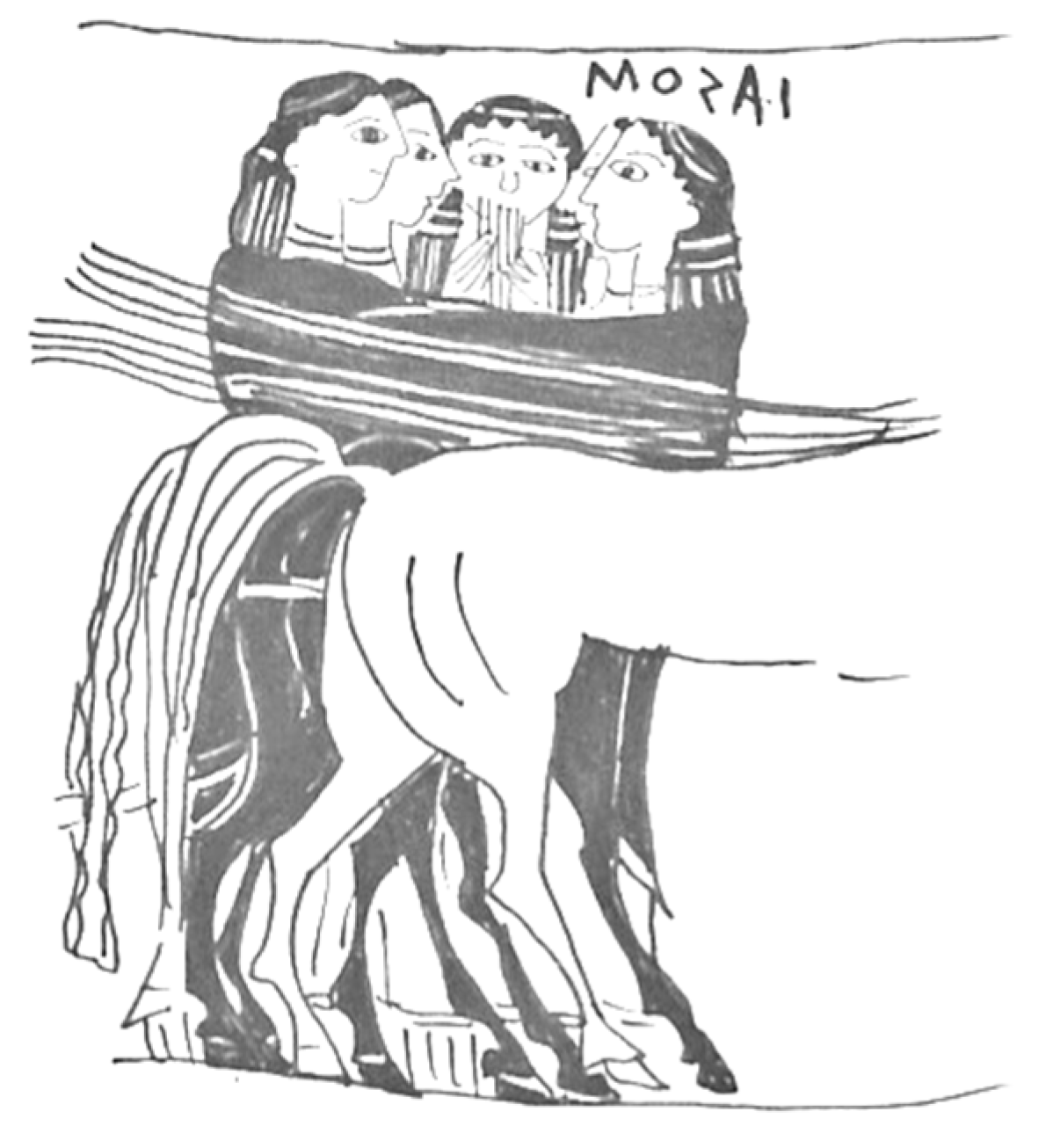
© 2019 by the author. Licensee MDPI, Basel, Switzerland. This article is an open access article distributed under the terms and conditions of the Creative Commons Attribution (CC BY) license (http://creativecommons.org/licenses/by/4.0/).
Share and Cite
Toillon, V. Three Women Sharing a Mantle in 6th Century BCE Greek Vase-Painting: Plurality, Unity, Family, and Social Bond. Arts 2019, 8, 144. https://doi.org/10.3390/arts8040144
Toillon V. Three Women Sharing a Mantle in 6th Century BCE Greek Vase-Painting: Plurality, Unity, Family, and Social Bond. Arts. 2019; 8(4):144. https://doi.org/10.3390/arts8040144
Chicago/Turabian StyleToillon, Valérie. 2019. "Three Women Sharing a Mantle in 6th Century BCE Greek Vase-Painting: Plurality, Unity, Family, and Social Bond" Arts 8, no. 4: 144. https://doi.org/10.3390/arts8040144
APA StyleToillon, V. (2019). Three Women Sharing a Mantle in 6th Century BCE Greek Vase-Painting: Plurality, Unity, Family, and Social Bond. Arts, 8(4), 144. https://doi.org/10.3390/arts8040144



